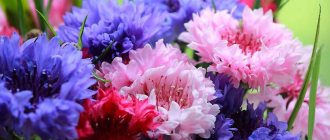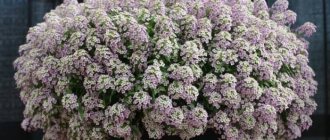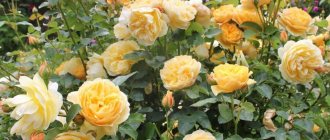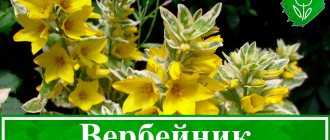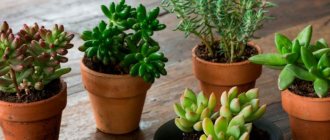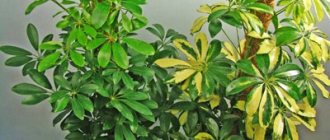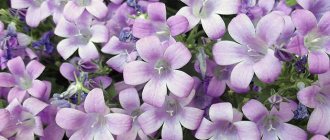Photo: ogo.ua The proud, handsome rhododendron is a permanent resident of the best gardens and parks in Europe. It decorates city flower beds and private collections, and is gradually replacing roses in the design of plots. The densely flowering shrub is the most spectacular of its kind. It is impossible to believe that its closest relatives are cranberries and lingonberries, inconspicuous from a decorative point of view!
general information
Despite the fact that the name rhododendron literally translates as “rose tree,” it has nothing to do with roses. The only thing they have in common is the variety of varieties and fabulous beauty during flowering. And rhododendron belongs to the heather family.
It is most commonly found in the Himalayas, Southeast Asia and Southern China. Some species grow in Japan, North America, New Guinea and Australia. But they are all very different, from tiny creeping shrubs to entire trees.
The length of rhododendron stems in the wild can reach an astonishing 30 m. The flowers can be quite miniature, and sometimes exceed 20 cm in diameter. But there are also compact varieties that love to be grown on windowsills.
Photo: shark-media.ru
What location is suitable for rhododendrons?
The place for planting rhododendron bushes must be chosen taking into account the fact that the plant does not tolerate winds and sudden changes in temperature. Therefore, a flower bed must be reliably protected from both the sun and winds.
There should be no trees with a shallow root system near rhododendron bushes:
- ate;
- linden;
- birch;
- chestnut;
- aspen;
- elm;
- maple.
Such “neighbors” will take away nutrition and moisture from the flowers, destroying them. Nearby you can plant pine or oak trees, as well as fruit trees. In any case, rhododendrons should be outside the crown cover so that sufficient rainfall feeds the bushes.
Rhododendron species
The rhododendron genus is surprisingly diverse, combining deciduous trees and evergreen shrubs. About eighteen species are common in our country. Let's look at some of them!
Golden rhododendron
An evergreen, squat variety spreads near the ground at a height of about 30-50 cm. It has a spreading crown with large long leaves up to 8 cm long, strewn with yellow-golden flowers. Golden rhododendron lives in the Far East, Altai Territory, Mongolia and some regions of Japan.
Photo: treespk.ru
Albrecht's rhododendron
The most popular Japanese variety decorates many mid-latitude gardens. The shrub grows up to one and a half meters and is densely covered with bright pink or red flowers with an olive center. This rhododendron grows very slowly, but lives up to 30 years.
Photo: energysad.ru
Katevba rhododendron
A spectacular winter-hardy bush, covered with long leathery leaves, stretches up to 4 m. Large inflorescences bloom on it, each of which consists of 15-20 flowers of an unusual purple-lilac hue.
Photo: treespk.ru
Rhododendron Vazea
Alpine rhododendron thrives in northwestern latitudes. This is a shrub, up to 2-5 m with small bright leaves and pale pink flowers. In autumn it turns a rich crimson color and remains decorative. Vazea is considered one of the most beautiful wild rhododendrons.
Photo: flower.onego.ru
Caucasian rhododendron
A low, spectacular rhododendron up to half a meter high often grows creeping, so it looks good in garden landscaping. It has unusual, leathery, oval-shaped leaves with slightly curled edges. The flowers look like funnels of a yellowish or greenish color.
Photo: packagile.ru
Atlantic rhododendron
The North American variety loves moist forests, swamps and sandy coasts. Although it grows to little more than half a meter, it has a dense, spreading crown with large, ovate leaves. The white flowers have a pink tint and are renowned for their strong scent.
Photo: flower.onego.ru
Yellow rhododendron
This beautiful, delicate variety is also called Pontic azalea. It is notable for its large vanilla-yellow or orange flowers with a distinct aroma. This is a deciduous, frost-resistant variety that grows upward from 2 m.
Photo: domashniecvety.ru
Kamchatka rhododendron
A squat, low shrub stretches up to 40 cm, but spreads well throughout the territory. It has small rounded leaves and expressive purple-pink flowers up to 4 cm in diameter.
Photo: pibig.info
Carpal rhododendron
Rhododendron, originally from China, rarely grows above half a meter in the garden. It has a beautiful and neat rounded crown that does not require regular shaping. White, pink or scarlet flowers only one and a half centimeters long are collected in funnels at the tops of the stems.
Photo: cherkessk7m.ru
Blushing rhododendron
An elegant evergreen variety blooms in mid-spring with beautiful purple flowers. Their diameter is only 2.5 cm, but the inflorescences seem large because they consist of 4-5 flowers. Blushing Rhododendron has almost no scent, so this is your choice if you can't stand strong scents.
Photo: econet.ru
Hydrangea (80 photos): types and features of care
Autumn care, shelter
Most rhododendrons cannot tolerate severe winter frosts. Therefore, starting in the fall, they need to be provided with shelter. Do this after the first frost. Sprinkle the horse's neck with dry leaves, preferably oak leaves. It is recommended to cover low-growing varieties completely. Make a frame around the bush and cover it with lutrasil. The branches of taller rhododendrons are bent to the ground and pinned with hooks. Cover the top with spruce branches. Evergreen varieties that overwinter with leaves must be protected from direct sun. Frames are made for them from roofing felt or plywood. They protect the bush not only from the sun, but also from strong winds.
With the onset of spring, when the snow melts, the frame can be removed. It is better to choose a cloudy day for this. In regions with warm climates, many types of rhododendron do not need shelter, as they are considered quite frost-resistant.
Rhododendron care
Rhododendrons are grown in greenhouses and in rooms, but the general care features remain the same. The main thing is to properly organize wintering and maintain stable temperature and humidity conditions.
Temperature and lighting
Rhododendron prefers more bright light, so it feels good even on the south side. Take indoor flowerpots outside in the summer, but shade them from direct rays. The ideal temperature is about 22 degrees, but 16-18 will do. For the winter, indoor varieties are placed in a cold place (5-8 degrees) for at least a month and a half so that future buds ripen.
Photo: cshh.ru
Watering
In summer, rhododendron is watered every time the top layer of soil dries out. Use only settled warm water, and for indoor flowerpots alternate top and bottom watering. Keep in mind that the flower does not tolerate dry air, so spraying several times a day is normal practice during drought.
Photo: domashniecvety.ru
The soil
Special heather soil is best suited for rhododendron, but moist peat soil will also work. Keep in mind that the flower grows for a long time and needs different conditions at different times of its life. For the winter, the bushes are insulated with spruce branches, spruce branches and burlap. But in warm latitudes, where there are not too severe frosts, this is not necessary.
Photo: zen.yandex.ru
Fertilizers and fertilizing
Rhododendron loves feeding, even if they are very young plants that have not yet bloomed. Use liquid mixtures with the addition of rotted manure or horn meal from early spring until the end of flowering. Make sure that the mail remains acidic, so choose the right formulations.
Photo: floraved.net
Transplantation and propagation
The easiest way to propagate rhododendron is by cuttings, when part of the long branches is dug into the ground. To do this, select several flexible young shoots, bend them into a ditch and cover them with garden soil. The part of the shoot that will remain on top requires vertical support. Already in the fall or next spring you can cut off the branch from the parent and replant.
Rhododendron planted from seed will take 6-8 years to bloom, so be prepared for a long wait. The seedlings spend the first month under film, and the entire first year in a cool greenhouse. When picking, be sure to deepen the cotyledons so that the root system develops better. Young bushes are transplanted into the ground only in the second year.
Photo: giashop.ru
Cuttings are another rather long and complex method, for which you will need semi-lignified stems 5-8 cm long. Tear off the lower leaves from them and place them in a stimulating solution for root growth. Use a substrate of sand and peat and cover the young seedlings with a transparent dome.
Rooting of cuttings can last from 1.5 to 4.5 months, depending on the variety. Then they are planted in boxes, the next spring they are dug into the ground with the boxes, and after 1-2 years they are transplanted to a permanent place.
Photo: datchnik.ru
Trimming
Rhododendrons are naturally very good and neat, so they do not need pruning for shaping. Only rejuvenation or preventive pruning is carried out if the bush has become too tall. After winter, be sure to cut off frozen stems, but it is important to do this before the weather warms up and the sap begins to flow actively.
Photo: farmer.blog
Tree hydrangea: varieties, care features (60 photos)
Time and rules for planting rhododendrons in the Moscow region
The plant can be planted in the ground from April to May and from September to November. Do not plant flowering plants - this will lead to their death.
For planting, choose a shady place with loose, acidic soil. The bed should be raised a few centimeters. It is not recommended to choose an area where there are large plants. Their roots can become entangled, causing the death of the rhododendron. Neighborhood with maple, chestnut, poplar, elm, alder and linden leads to the death of the plant. This is because their roots are close together and larger trees will take up nutrients.
Before planting, fertilize the soil with humus. A hole 60 cm wide is dug. Peat and clay are added to the mixture (in a ratio of 8 to 3.5). Then the seedling is immersed in water and the soil is compacted. Cover with moss and peat and water thoroughly.
Pest and disease control
The main scourge of all rhododendrons is the rhododendron bug, which leaves whitish spots on the leaves. It is a large parasite, up to 3-4 mm in size, so it can be noticed even this way. The bug lays eggs on the back of the plates, and new offspring wake up after wintering.
Rhododendron also faces more typical problems - spider mites or weevils. Thrips, garden beetles or narrow-winged moths may appear. The principle of operation is the same - timely treatment of seedlings with insecticides.
If yellow spots grow on the tips of rhododendron leaves, this is most likely mixed chlorosis. The most common reasons are lack of fertilizers or stagnant water. Another indicator of nutritional deficiency is red-brown spots along the veins. And if the rhododendron is too cold, the leaves may even die off.
Photo: mm-ewm.ru
Outdoor care
As with other garden crops, caring for rhododendron includes classic manipulations (watering, weeding, fertilizing, pruning). For the successful development of the shrub, their competent implementation is necessary.
Watering
Correct watering is of great importance. This significantly affects the formation of buds. Only soft water is suitable for irrigation. It can also be acidified and softened with high-moor peat. Add it a day before watering. Acidify the water with oxalic, citric or acetic acid (3 g per 10 liters of water).
During watering, the soil should be saturated with moisture 20-30 cm deep. It is important that there is no stagnation of liquid, otherwise the root system will suffer. The standard watering rate is 1-1.5 buckets of water per adult plant once a week. Young rhododendrons are watered more often, using 5 liters of water per bush. In dry weather, including autumn, the plant's need for water increases. When the air is dry and hot, you can spray the bush.
Feeding and fertilizer
The crop needs to be constantly fed, even if it was planted this season. Fertilizing begins in early spring and ends at the end of July, after flowering ends. First, half-rotted manure is added, it is diluted with water 1:15 and infused for several days. Before fertilizing the bush, it needs to be watered. Mineral compounds are also useful for rhododendron: superphosphate, potassium sulfate, potassium phosphate, ammonium sulfate. Potassium, magnesium and calcium are added in very low concentrations.
Bush formation and pruning
Rhododendrons practically do not need pruning, since their crown contours are regular. Sanitary pruning of dry branches is carried out periodically to rejuvenate the bush. The procedure is carried out in early spring. If the cut stems are thinner than 4 mm, then they are treated with garden varnish. You can shorten the shoots to make the plant bushier. But leave at least ¾ of their length. It is also recommended to remove all dry inflorescences after flowering. This stimulates the formation of new buds.
Rhododendron – photo
Rhododendrons look great alone or in groups with other moisture-loving plants. They are regularly used for landscaping areas. Just look how beautiful it is!
Photo: agroevropa.ru
Photo: flo.discus-club.ru
Photo: flo.discus-club.ru
Photo: tapeciarnia.pl Photo: cvetyphoto.blogspot.com
Photo: tr.pinterest.com Photo: vladimirkrym.livejournal.com
Photo: attuale.ru
Photo: attuale.ru
Photo: 10wallpaper.com
Photo: dlobal.ru
Photo: domashniecvety.ru
Photo: vladimir-shalaev.tourister.ru
Photo: pibig.info
Photo: u-florista.ru
Photo: bskod.ru
Photo: interjer-plus.ru
Photo: rhodoland.nl
Photo: aredi.ru
Photo: bezgoroda.com
Photo: dlobal.ru
Photo: distano.ru
Photo: oir.mobi Photo: peakpx.com
Photo: zen.yandex.ru
Photo: dachneek.ru
Ageratum (70 photos): types and features of care
Rhododendron degronianum ssp. yakushimanum
A popular mountain species that came from Japan to Europe in the 30s of the twentieth century. A compact shrub up to 1 m high and 1.5 m in diameter, from the end of May it is completely covered with dense, numerous inflorescences.
The “apple blossom” effect is achieved through bright pink buds and flowers ranging from soft pink to white.
Rhododendron yakushimanensis
Many varieties overwinter reliably and bloom well, for example Ken Janeck, Mist Maiden, Koichiro Wada, Yaku Angel.
Use in landscape design
Dwarf rhododendrons are used to create alpine slides and mixed rocky gardens - mixborders. The varieties look good in compositions with thujas, cypresses and other coniferous plantings.
Other types of rhododendrons are also widely used in landscape design, for example: Azurro, Fantastica, Francesca, Rasputin, Ledebura, Zolotisty, Daursky, Polarnacht, Schlippenbach and Katevbinsky. They are distinguished by their bright colors, different leaf shapes and have different flowering periods.
Reproduction
Dwarf rhododendron in home floriculture is propagated by cuttings:
- In spring, cuttings 8 cm long are cut.
- The cuttings are dipped for 24 hours in a solution with a root growth stimulator.
- Planted in a prepared special substrate to a depth of 2 cm.
- The seedlings take root very slowly.
- Seedlings are planted in open ground for next spring.
- Young seedlings are grown in the cellar.
